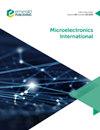促进配体交换策略促进油胺封端Ag纳米粒子的低温纳米烧结
IF 0.8
4区 工程技术
Q4 ENGINEERING, ELECTRICAL & ELECTRONIC
引用次数: 0
摘要
目的本研究旨在开发一种简单的配体交换策略,以促进油胺(OAM)封端的银纳米粒子(AgNPs)的纳米烧结。通过与NH4OH的配体交换过程去除AgNP表面的OAM,本研究报告了有效降低AgNP的烧结温度以实现低温纳米烧结。与OAM封端的未经处理的AgNPs相比,NH4OH处理的AgNP具有优异的烧结性能,可作为导体应用于分数发生器器件,并有利于制造柔性电路模块。设计/方法/途径首先,以油胺为还原剂,采用简单的一步法制备单分散AgNPs。然后与NH4OH在不同处理时间进行配体交换以去除OAM,并应用微傅立叶变换红外光谱和接触角测试来阐明这些过程的机理和结构特征。最后,使用NH4OH处理的AgNPs沉积烧结在不同温度下测试电阻率,并使用非原位扫描电子显微镜结合原位X射线衍射来研究整个纳米烧结过程中微观结构的变化。发现AgNPs总是被有机配体封端,以防止纳米颗粒团聚。油胺作为还原剂可以合成8–32的理想尺寸分布 nm,具有单分散的球形,但油胺封端的AgNPs似乎无法实现低温纳米烧结,因为OAM是一种具有长C链的有机物。配体交换方法能够用低热稳定性的有机配体取代封端在AgNPs上的原始有机配体,这可以促进纳米烧结。配体交换处理后的AgNPs可以在相纸、聚二甲基硅氧烷(PDMS)和聚对苯二甲酸乙二醇酯柔性基板上低温烧结。原创性/价值在本研究中,使用配体交换的方法来改变AgNPs的配体。在配体交换过程中,NH4OH被用于处理AgNPs。通过NH4OH的处理,成功地实现了AgNPs亲水性和疏水性的改变。AgNPs的烧结温度也可以降低,并且性能可以得到改善。最后,使用PDMS作为基底,评估了这种低温纳米烧结工艺的AgNPs沉积物用于获得导电图案的适用性。本文章由计算机程序翻译,如有差异,请以英文原文为准。
Facile ligand-exchange strategy to promote low-temperature nano-sintering of oleylamine-capped Ag nanoparticles
Purpose
This study aims to develop a facile ligand-exchange strategy to promote nano-sintering of oleylamine (OAM)-capped silver nanoparticles (AgNPs). By using ligand exchange process with NH4OH to remove OAM from the surface of AgNP, this study reports effectively reducing the sintering temperature of AgNPs to achieve low-temperature nano-sintering. Compared with untreated AgNPs of OAM-capped, NH4OH-treated AgNPs possess superior sintering performance that could be applied to a fractional generator device as conductor and in favour of the fabrication of flexible circuit modules.
Design/methodology/approach
First, oleylamine is used as reductant to synthesize monodisperse AgNPs by a simple one-step method. Then ligand exchange is used with NH4OH at different treating times to remove OAM, and micro-Fourier transform infrared spectroscopy and contact angle test are applied to clear the mechanism and structure characteristics of these processes. Finally, NH4OH-treated AgNPs sediment sintering is used at different temperatures to test electrical resistivity and use ex situ scanning electron microscopy combined with in situ X-ray diffraction to study changes in microstructure in the whole nano-sintering process.
Findings
The AgNPs are always capped by organic ligands to prevent nanoparticles agglomeration. And oleylamine used as reductant could synthesize desirable size distributions of 8–32 nm with monodisperse globular shapes, but the low-temperature nano-sintering seemed not to be achieved by the oleylamine-capped AgNPs because OAM is an organic with long C-chain. The ligand exchange approach was enabled to replace the original organic ligands capped on AgNPs with organic ligands of low thermal stability which could promote nano-sintering. After ligand exchange treated AgNPs could be sintered on photo paper, polydimethylsiloxane (PDMS) and polyethylene terephthalate flexible substrates at low temperature.
Originality/value
In this research, the method ligand exchange is used to change the ligand of AgNPs. During ligand exchange, NH4OH was used to treat AgNPs. Through the treatment of NH4OH, the change of hydrophilic and hydrophobic properties of AgNPs was successfully realized. The sintering temperature of AgNPs can also be reduced and the properties can be improved. Finally, the applicability of the AgNPs sediment with this nano-sintering process at low temperature for obtaining conductive patterns was evaluated using PDMS as substrates.
求助全文
通过发布文献求助,成功后即可免费获取论文全文。
去求助
来源期刊

Microelectronics International
工程技术-材料科学:综合
CiteScore
1.90
自引率
9.10%
发文量
28
审稿时长
>12 weeks
期刊介绍:
Microelectronics International provides an authoritative, international and independent forum for the critical evaluation and dissemination of research and development, applications, processes and current practices relating to advanced packaging, micro-circuit engineering, interconnection, semiconductor technology and systems engineering. It represents a current, comprehensive and practical information tool. The Editor, Dr John Atkinson, welcomes contributions to the journal including technical papers, research papers, case studies and review papers for publication. Please view the Author Guidelines for further details.
Microelectronics International comprises a multi-disciplinary study of the key technologies and related issues associated with the design, manufacture, assembly and various applications of miniaturized electronic devices and advanced packages. Among the broad range of topics covered are:
• Advanced packaging
• Ceramics
• Chip attachment
• Chip on board (COB)
• Chip scale packaging
• Flexible substrates
• MEMS
• Micro-circuit technology
• Microelectronic materials
• Multichip modules (MCMs)
• Organic/polymer electronics
• Printed electronics
• Semiconductor technology
• Solid state sensors
• Thermal management
• Thick/thin film technology
• Wafer scale processing.
 求助内容:
求助内容: 应助结果提醒方式:
应助结果提醒方式:


